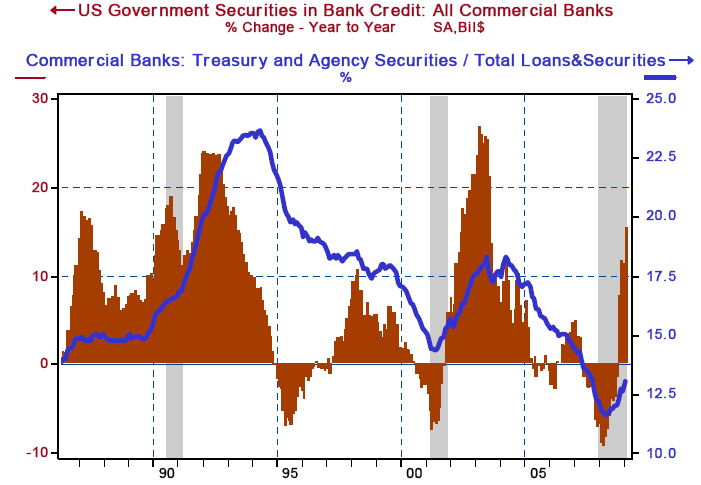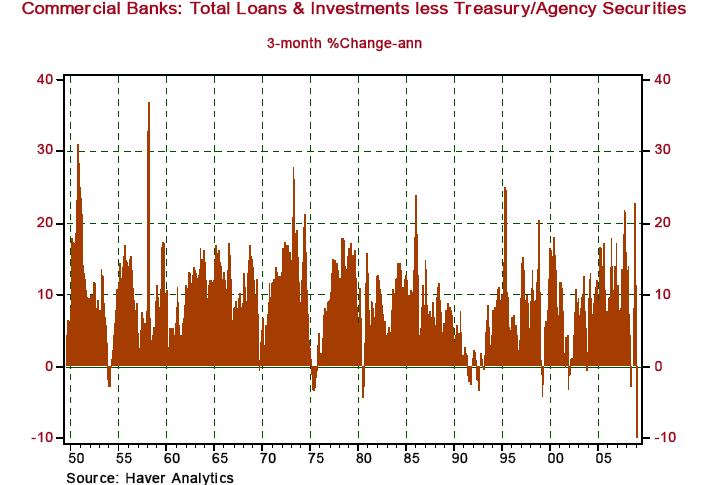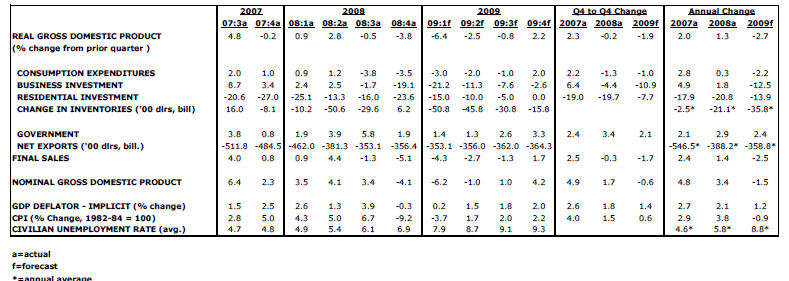U.S. Economy 4th Quarter 2009 Recovery, SIVs to the Rescue?
Stock-Markets / US Stock Markets Feb 20, 2009 - 03:03 AM GMTBy: Paul_L_Kasriel

 We apologize for the tardiness and brevity of this update. We have been on the peas-and-chicken circuit for the better part of two months, which has consumed much of our time and energy. A lot has transpired since our January update. Congress passed and the president signed a $787 billion fiscal stimulus program. Treasury Secretary Geithner, after paying his back taxes, changed the name of the financial institution rescue program from TARP to FSP (Financial Stability Program). The Obama administration announced a $75 billion program to facilitate the modification of at-risk home mortgages. And the Commerce Department released its first guesstimate of Q4:2008 GDP.
We apologize for the tardiness and brevity of this update. We have been on the peas-and-chicken circuit for the better part of two months, which has consumed much of our time and energy. A lot has transpired since our January update. Congress passed and the president signed a $787 billion fiscal stimulus program. Treasury Secretary Geithner, after paying his back taxes, changed the name of the financial institution rescue program from TARP to FSP (Financial Stability Program). The Obama administration announced a $75 billion program to facilitate the modification of at-risk home mortgages. And the Commerce Department released its first guesstimate of Q4:2008 GDP.
In this commentary, we want to concentrate on the fiscal stimulus program and FSP. But before doing so, let's discuss the Q4 GDP data. Real GDP is estimated to have contracted at an annualized rate of 3.8% - the sharpest contraction since Q1:1982's 6.4% contraction. As bad as the fourth quarter contraction was, had it not been for the estimated 1.3% contribution to real GDP from inventory accumulation, the headline would have been worse. The only major category of final demand that increased in the fourth quarter was federal government spending. Personal consumption, residential investment, nonresidential investment, business equipment and software, exports and state/local government expenditures all were down. Real final sales of domestic product contracted at an annualized rate of 5.1% - the worst showing since Q2:1980's 7.5% contraction. December data for inventories and real net exports suggest a downward revision to the Commerce Department's advance estimate of real GDP.
Based on the Commerce Department's advance estimate of fourth-quarter real GDP , our estimate of the Q1:2009 real GDP change is a 6.4% annualized contraction. Detroit was effectively closed for the month of January and is not expected to produce many cars and trucks in February and March. As a result, a large part of first-quarter sales of motor vehicles is likely to come from dealer inventories. In fact, many businesses are trying to clean out their inventories. Thus, we expect a sharp runoff of real inventories, which will weigh heavily on the first-quarter headline real GDP figure. The better news, however, is that the contraction in real final sales of domestic product is expected by us to be less severe than what occurred in the fourth quarter. If fourth-quarter business inventories are revised down, as we expect, then our first-quarter estimated headline real GDP figure is likely to be revised up - i.e., the rate of contraction is likely to be less severe.
We believe that this current quarter will be the worst in terms of contraction for the recession. The rate of decline of real economic activity is expected to be less severe in the second and third quarters. Then, for the fourth quarter, we are forecasting some growth.
What is the basis of this fourth-quarter recovery? The effects of increased federal government spending and tax rebates from the fiscal stimulus program largely financed by the banking system and/or the Federal Reserve . If the Fed and the banking system do not "print" the money to fund the increased federal government spending and tax rebates contained in the fiscal stimulus package, aggregate demand will not be "stimulated." Rather, the composition of aggregate demand will change, but not the total. Banks can fund themselves in the overnight fed funds market at about ¼%. Two-year Treasury securities are yielding approximately 0.90%. Although a 65 basis-point spread is nothing to write home about, there is no credit risk involved.
If banks purchase two-year Treasury securities in size, then their profits and retained earnings will begin to perk up. But will banks be able to purchase Treasury securities in size? Won't they be constrained by their lack of capital? Because there is no credit risk involved in the purchase of Treasury securities, there is no risk-based capital charge incurred when banks purchase them. The only meaningful constraint on bank purchases of Treasury securities is their respective overall leverage ratios - total assets in relation to their capital. As Chart 1 shows, commercial banks were huge buyers of Treasury securities, both in absolute and relative terms, in the early 1990s, a time when banks were suffering from extreme capital deficiencies. If the banking system is a big buyer of Treasury securities, bank deposits will increase, all else the same. This will increase banks' demand for reserves. The Fed will be induced to purchase some assets - Treasury securities or something else - in order to satisfy the increased demand for reserves. Otherwise, the fed funds rate would start to drift up, something the Fed has implicitly pledged to prevent in the foreseeable future.
Chart 1

In the three months ended January, bank loans and investments excluding Treasury and government agency securities - essentially bank credit to the private sector - contracted at an annualized rate of 9.9%, which is the sharpest three-month contraction in the post-WWII era (see Chart 2). Of course, with the economy enduring what is likely to be its most severe recession in the post-WWII era, lenders are scrutinizing the credit quality of prospective borrowers much more carefully. Perhaps equally important, because of past and expected credit losses, bank capital is a scarce commodity for the banking system. Thus, some banks cannot expand their lending to the private sector by as much as they otherwise would prefer to because of risk-based capital constraints. The private sector, therefore, has been put on very tight credit rations.
Chart 2

This is where the Financial Stability Program can help. The details of the FSP as they relate to the "private/public" bank and stress tests of financial institutions have not been released. But the details of one of the elements of the FSP - the expansion of the Federal Reserve's Term Asset-Backed Securities Lending Facility (TALF) - are clear. The goal of TALF is to begin a thawing process in the frozen asset-backed securities markets. These asset-backed securities involve many types of private-sector credit, e.g., credit card, auto loan, student loan, residential real estate mortgage and commercial real estate mortgage debt. The Federal Reserve proposes through TALF to provide non-recourse financing to entities that purchase newly-issued securitized debt with a credit rating of AAA. The term of these loans would be three years. The borrowers could opt for a floating rate loan, priced at 100 basis points over one-month Libor, or a fixed rate loan, priced at 100 basis points over three-year Libor.
The Fed would not lend 100% of the face value of these securities, but would lend an amount at something less than face value in order to protect us taxpayers against some future loss in the value of these securities. However, due to the non-recourse nature of these loans, if the value of the securities (collateral) were to fall further below their originally-discounted value, the Fed would accept the credit loss. (This means that we, the taxpayers, would absorb any losses.) When TALF was first proposed, back in November of last year, its funding allocation was $200 billion. Under the Treasury's new FSP, TALF's funding amount has been increased to $1 trillion .
The TALF program is essentially a Structured Investment Vehicle (SIV) but with one important distinction - the Fed, with the largest capacity in the world to absorb losses, is providing the financing. Unlike what was the case with the original SIVs (SINs?), there can be no margin calls in the TALF version. With previous facilities, the Fed already had begun creating credit for the nonbank private sector. For example, the Fed has been purchasing commercial paper, short-term uncollateralized loans, from corporate issuers (borrowers). TALF expands the capacity for the Fed to, in effect, create credit for the private sector. We believe that TALF will be the most important element of the FSP to increase the flow of credit to the private sector in the coming 12 months.
Other elements of the FSP are only tangentially related to getting private-sector credit flowing again. As far as we can tell (and that is not very far), the stress-test element is more of a "purge and merge" program. The (arbitrary) stress tests will allegedly reveal which banks have a decent chance of surviving and which do not. The "terminally ill" will be purged of their poisonous assets and merged into those with better chances of survival. Presumably, stockholder equity of the terminally ill banks will be wiped out. Taxpayers will bear the costs of any unrecoverable losses of purged assets. For the life of us, we still do not understand the rationale for the private/public bank. If its principal purpose is to place a value on poisonous assets, we think there is a better way ( see our January 29, 2009 The Econtrarian , "Channeling Bob Laurent" ).
In sum, we believe that the nadir of this recession is occurring now. Moreover, we believe that the combination of the $1 trillion TALF program and the $787 billion fiscal stimulus program, assuming it is financed by the banking system and the Fed, will have a salutary effect on aggregate real activity, perhaps inducing an economic recovery by the fourth quarter of this year.
*Paul Kasriel is the recipient of the Lawrence R. Klein Award for Blue Chip Forecasting Accuracy
THE NORTHERN TRUST COMPANY
ECONOMIC RESEARCH DEPARTMENT
February 2009
SELECTED BUSINESS INDICATORS
Table 1 US GDP, Inflation, and Unemployment Rate

Table 2 Outlook for Interest Rates

By Paul L. Kasriel
The Northern Trust Company
Economic Research Department - Daily Global Commentary
Copyright © 2009 Paul Kasriel
Paul joined the economic research unit of The Northern Trust Company in 1986 as Vice President and Economist, being named Senior Vice President and Director of Economic Research in 2000. His economic and interest rate forecasts are used both internally and by clients. The accuracy of the Economic Research Department's forecasts has consistently been highly-ranked in the Blue Chip survey of about 50 forecasters over the years. To that point, Paul received the prestigious 2006 Lawrence R. Klein Award for having the most accurate economic forecast among the Blue Chip survey participants for the years 2002 through 2005.
The opinions expressed herein are those of the author and do not necessarily represent the views of The Northern Trust Company. The Northern Trust Company does not warrant the accuracy or completeness of information contained herein, such information is subject to change and is not intended to influence your investment decisions.
Paul L. Kasriel Archive |
© 2005-2022 http://www.MarketOracle.co.uk - The Market Oracle is a FREE Daily Financial Markets Analysis & Forecasting online publication.


